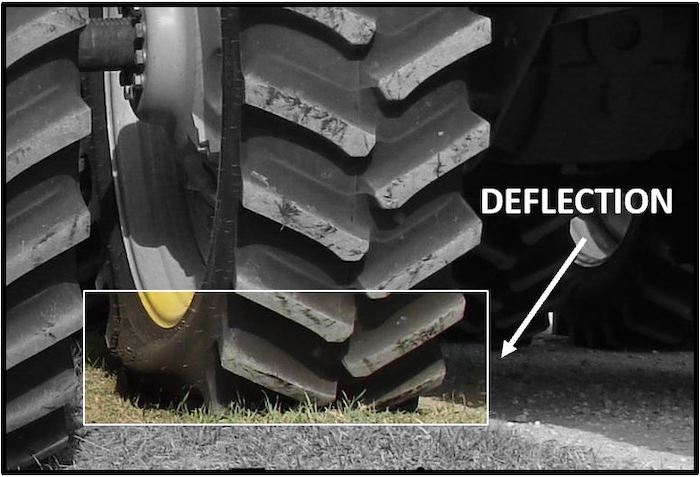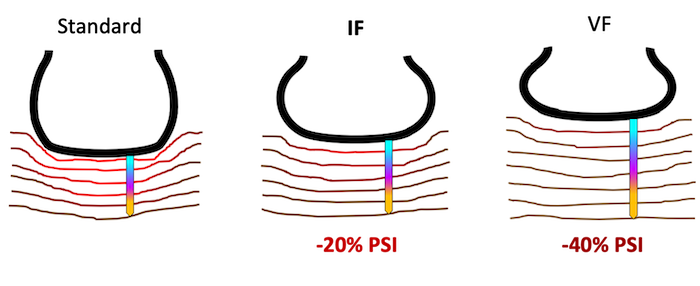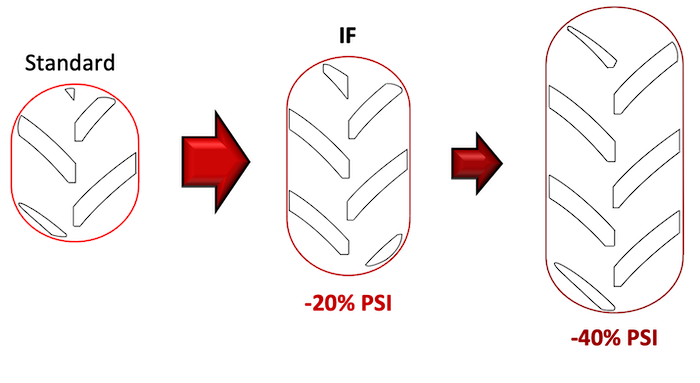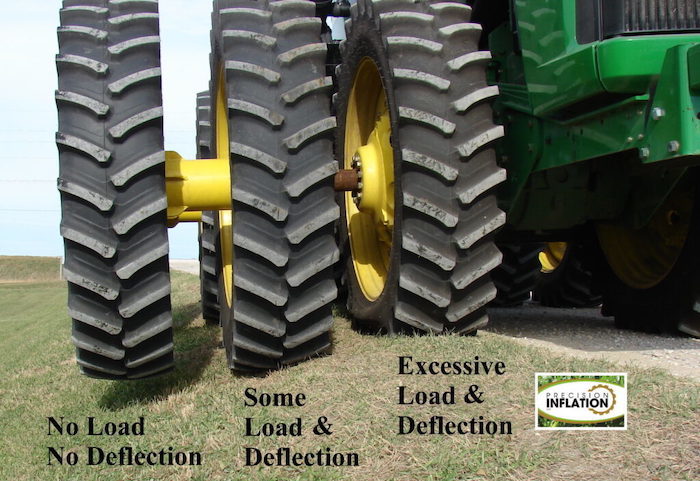Editor’s Note: This Q&A originally appeared in AG Tire Talk to provide answers that farm equipment dealers have about farm track technology. This series features a trending question followed by an abridged version of the answers. For the complete answers, check out www.agtiretalk.com
AG TIRE TALK KEY TAKEAWAYS
- MAXAM, “Tire deflection is the amount of “bulge” the tire lowers under load as the weight or torque is applied to the tire by the equipment axle.”
- PRECISION INFLATION, “What is the best or optimum deflection? There are at least 2- one for ROAD and one for FIELD.”
- MICHELIN, “Proper sidewall deflection of a tire allows it to achieve optimum performance by maximizing footprint.”
- CONTINENTAL, “The higher the load and the lower the inflation pressure, the bigger the resulting contact patch area…”
- ALLIANCE, “When a tire is experiencing proper deflection, the tire’s sidewall is flexing (or bulging) the way it was designed to, its contact patch with the ground is optimum, and you’re reducing soil compaction and promoting even tire wear.”
- BKT, “Increased Flexion (IF) and Very High Flexion (VF) tires available now in the marketplace and uses deflection for both better traction and flotation.”
- CEAT, “The deflection of the sidewall acts as a bit of a shock absorber and improves ride quality. The more sidewall deflection the more the tire can flex to absorb impacts from bumps, lumps and obstacles during operation.”
- TRELLEBORG, “From the farmer’s perspective, how can he be certain in getting the largest footprint possible without the risk of damaging the tire? He needs to follow the tire data book recommendations and adjust the air pressure accordingly.”
- TITAN, “At the end of the day, lower inflation and higher deflection is here and staying up on these technologies are key for anyone’s operation moving into the future.”
Precision Inflation LLC, Ken Brodbeck, Vice President of Technology
Tire Deflection Matters! What does tire deflection affect? Almost everything.
Over Deflection = Under-Inflation
1. Shortens tire life / durability
2. Creates excessive heat
3. Can flex out the tire sidewall
4. Create fast and / or irregular wear
5. Poor lateral stability, squishy steering response
Not Enough Deflection = Over Inflation
1. Shorten tire life from potential impact breaks of tire body
2. Create irregular wear
3. Harsh stiff ride in both field and transport
4. Excessive soil compaction from high pressures
5. Poor traction due to short / small footprint causing excessive slippage
6. Rutting in soft fields
7. Good fuel economy on the road, but poor fuel economy in the field
What is the best or optimum deflection? There are at least 2- one for ROAD and one for FIELD.
- TRANSPORT: Are you transporting between fields at 30 mph with a heavy front fold planter?
- FIELD: Or pulling the same planter in the field at 5 to 9 mph?
- Ideally, we adjust/optimize the tire pressure
- TRANSPORT = HIGHER PSI = LESS DEFLECTION.
- FIELD = LOWER PSI = HIGHER DEFLECTION.
Michelin Ag, David Graden: Operational Market Manager – Agriculture
How many of you have heard the comment, “Michelin Tires have soft sidewalls?” I can’t count how many times I have heard this while being a Michelin AG field sales rep. My response usually was, “Yes; and it’s by design, this the Michelin bulge!” “Michelin has purposely engineered a large bulge or to use the technical term deflection to enhance the performance of the tire.”
Proper Deflection = Maximum Footprint
Proper sidewall deflection of a tire allows it to achieve optimum performance by maximizing footprint. Traction and flotation are two of the greatest benefits, with rider comfort and increased carrying capacity being an additional benefit.
IF / VF Maximizes Deflection
Michelin recognized then need to maximize deflection in the late 1990’s and early 2000’s. In response, we invented Michelin Ultraflex Tires (2004), also known as IF (increased flexion) and VF (very increased flexion) technology.
The basic engineering behind an IF/VF tire changes the point of deflection in the sidewall and, therefore, creates an even larger footprint. This technology is considered a standard, today.
Continental Agriculture North America, Harm-Hendrik Lange: Customer Solutions Engineer for Continental Commercial Specialty Tires (CST): Deflection means that the carcass supports the belt in changing the round shape in the contact area towards a flat shape. The higher the load and the lower the inflation pressure, the bigger the resulting contact patch area, creating a need for more deflection work by the carcass.
What interactions come with the effect of deflection?
- Low inflation pressure means less ground contact pressure, but requires higher deflection rates and big footprints.
- Those big footprints mean more lugs on the ground which results in better maximum traction for most soil conditions.
- Deforming the tire requires less energy compared to deforming soft soil, so flexibility of the tire is a big benefit for less fuel consumption, as long as the tire can hold the stress.
- With the belt behaving like a rubber track, the footprint mostly expands in length and less so in width as the inflation pressure is lowered or the load is increased.
- The higher the sidewall/aspect ratio, the more deflection work can be realized by the sidewall, so 85% aspect ratio can realize more footprint length than the same tire diameter and width with 65% ratio.
- In theory, a very thin and flexible carcass would be optimum for flotation, because it would consume almost no energy to deform/deflect while the tire is in rotation. But on the other hand, the carcass needs to be strong and resistant against inner and outer forces, which requires a certain thickness of material.
Finally, there are also some negative effects from high deflection:
- Deformation/deflection of the tire always requires a certain amount of energy consumption that mainly disappears as heat or, in suboptimal cases, heat build-up in the tire.
- Too strong deformation/deflection can exceed the potential of the tire and damage it. Too much deflection would cause a situation where the casing ply will fatigue after several repetitive load cycles.
- High deflection often comes with less ability to transfer lateral forces, meaning tires with lower air pressure are spongier and will start floating, which is not optimal for fast road transport or inclines.
Maxam Tire International, Greg W. Gilland: Business Development & Ag Segment Manager
What is Tire Deflection?
Tire deflection is the amount of “bulge” the tire lowers under load as the weight or torque is applied to the tire by the equipment axle. The deflection is the calculated difference in height between an “unloaded” tire section height and the “under-load” tire section height normally measured from tread face / shoulder to the wheel flange. The deflection amount or percentage is the difference in the two heights.
The “optimal” tire deflection in an agricultural tire ensures that as the tire compresses or deflects under the given load, the tire footprint extends to ensure that the maximum coverage is derived from the tread face delivering both the traction or flotation necessary for the equipment to work.
Adjusting the air pressure to ensure his tire deflection and resulting footprint is optimized to his working conditions will allow him to achieve:
- Traction (reduced fuel cost)
- Flotation (reduced compaction = greater yield)
- Faster through the field (labor cost)
- Improved tire life (tire value & wear life)
Alliance Tire Americas, Nick Phillippi, National Product Manager
Tire deflection, or the difference in radius between a loaded and unloaded tire, is caused by the flexing of the sidewall under load. Tire deflection is important in a number of ways. When a tire is experiencing proper deflection, the tire’s sidewall is flexing (or bulging) the way it was designed to, its contact patch with the ground is optimum, and you’re reducing soil compaction and promoting even tire wear.
Engineers design and manufacturers build tires to maintain a specific range of deflection to optimize the tires’ capabilities and service life. That’s why it is so important to match load and inflation pressure. Proper inflation pressure—when matched to the load and speed—is what allows a tire to deflect the way it is designed to. Too much pressure reduces deflection. Too little pressure allows the sidewall to flex too much.
If it’s not flexing enough, you’ll experience a rougher ride and reduce your footprint, leading to faster wear in the center of your tread. If a tire flexes too much, the movement of the sidewall creates friction and builds up heat, a sure way to ruin a tire before its time
BKT USA Inc., Dave Paulk, Manager Field Technical Services
Deflection is critical in radial tire performance because it allows the tire to flex and generate a wider contact area (footprint) with the ground. The increased contact patch generates higher traction and greater flotation characteristics. The benefits of increased traction include improved time efficiency, reduced fuel costs, and optimized machinery performance. Increased flotation characteristics lead to reduced soil disturbance and decreased soil compaction which in turn increases product yield.
Agricultural radial tires specifically are designed for tire deflection within specific ranges that that can help with both traction and flotation. Radial tires in general are designed to run with a degree of deflection. In contrast, Bias Ag tires cannot be run at low air pressures.
Maximizing traction is important to be able to cover more ground and save on fuel costs by eliminating unnecessary wheel slip. This allows the tractor to pull the equipment the way it is designed.
Maximizing flotation can minimize soil compaction and save the soil and increase the crop yield. It can minimize the creation of excessive ruts in a field and help with planting and harvest when the ground is wet.
Increased Flexion (IF) and Very High Flexion (VF) tires available now in the marketplace and uses deflection for both better traction and flotation.
IF tires can carry 20% more weight than a standard radial tire at the same air pressure. They can carry the same weight at approximately 20% less air pressure.
VF tires carry 40% more weight at the same air pressure as a standard radial tire and can carry the same weight at approximately 40% less air pressure. This allows the deflection of the tire to spread out the footprint of the tire to distribute the weight of the equipment and enhance traction and flotation which minimizes soil compaction.
CEAT Specialty Tires Inc., Jim Enyart, Technical Manager
Deflection Importance:
The sidewall on radial tires is designed to provide radial deflection that spreads the load over a larger area by increasing the footprint in length while maintaining uniform weight distribution. Sidewall deflection increases the length of the footprint the more the sidewall deflects which can optimize traction and flotation.
Bias tires also have sidewall deflection but that deflection is not in a radial fashion. Due to the bias construction the entire carcass is distorted as well as the weight distribution in the contact patch. The bias sidewall deflection does the same basic functions just not with the same results.
Traction Impact:
Radial sidewall deflection enables tires to increase the length of the contact area of the tread with the surface it’s traveling over. The larger the footprint the more compaction is reduced. The more deflection in the sidewall the longer the footprint will grow, to a point. The contact area will be at its’ maximum length with no air pressure in the tire. This will not work for long because air carries the load in all pneumatic tires. Flat and under inflated tires will be damaged due to over deflection of the sidewall in the shoulder and bead areas. The more under inflated a tire is for the load the quicker and more extensive the damage will be. You need to hit the “happy medium” by inflating to the most demanding application to avoid tire damage and to maximize flotation and traction by maximizing sidewall deflection.
Trelleborg Wheel Systems, Norberto Herbener, OE Applications Engineer
Why is deflection important and how does it affect the tire performance? The tire plays the middle part between the transmission and the ground and is responsible to deliver the power and torque with high efficiency. It is known that the more lugs in contact with the ground, the higher the power transmission. Apart from tire lug design (shape, depth, quantity etc.) the way to have more lugs on the ground is to increase the contact area between tire and ground. It is not only the width that makes a difference, but also the length of the contact area. If you have a more flexible tire, it will be capable of increasing the footprint area compared to a rigid sidewall design tire. Also, it can increase the footprint, the traction and reduce compaction.
From the farmer’s perspective, how can he be certain in getting the largest footprint possible without the risk of damaging the tire? He needs to follow the tire data book recommendations and adjust the air pressure accordingly. Some simple steps:
- Determine what is the load each tire must hold
- Search for the correct inflation pressure based on the working speed that the load will be applied
- This will assure the tire will provide the correct deflection, maximize the footprint and transfer the transmission power to the ground with the highest efficiency.
- This correct tire air pressure will achieve the largest footprint and lowest soil compaction. Note: Studies have shown that over inflating reduces the footprint (also traction and flotation) and under inflating can damage the tire.
Titan International Inc. (Manufacturer of Titan and Goodyear Farm Tires), Scott Sloan, Ag Product Manager/Global LSW
Tire technology has evolved to help minimize the impact on the soil, IF/VF technology and high flotation tires have become more and more popular. These tires carry the loads but due to the design it allows the tires to deflect more thereby allows the tires footprint to grow larger and spread the load over a larger area, which reduces ground-bearing pressures and minimizes compaction. Deflection technology in tires has been around for 15+ years. Acceptance has been slow but is making its way onto most equipment now.
Deflection when talking about tires in laymen’s terms is the amount the tire squats or the amount the sidewall bulge’s. Deflection technology like IF and VF allows the tire to run with 20% and 40% less inflation pressure than standard tires. IF and VF tires “look flat” or have much higher deflections than standard tires.

Having a larger footprint accomplishes two things not only does the larger footprint reduce soil compaction but also it also puts more lugs on the ground increasing its tractive efficiency and in turn improves fuel efficiency.

Deflection when talking about tires in laymen’s terms is the amount the tire squats or the amount the sidewall bulge’s. Deflection technology like IF and VF allows the tire to run with 20% and 40% less inflation pressure than standard tires. IF and VF tires “look flat” or have much higher deflections than standard tires.

Having a larger footprint accomplishes two things not only does the larger footprint reduce soil compaction but also it also puts more lugs on the ground increasing its tractive efficiency and in turn improves fuel efficiency.







